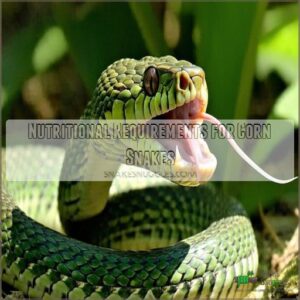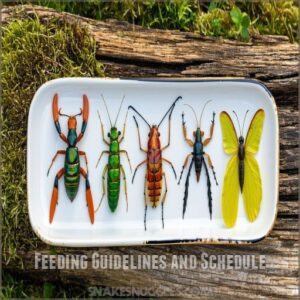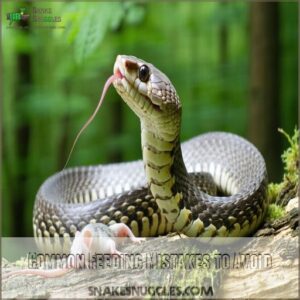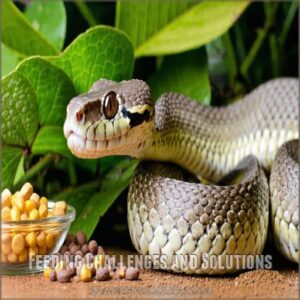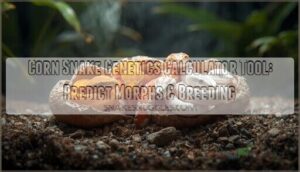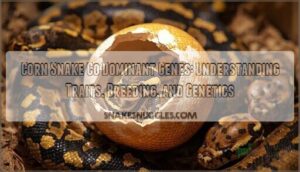This site is supported by our readers. We may earn a commission, at no cost to you, if you purchase through links.
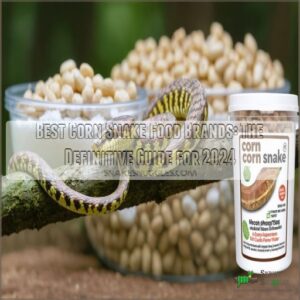 When dealing with feeding your corn snake, you’ll want to choose the best brands that offer a balanced, nutritious diet.
When dealing with feeding your corn snake, you’ll want to choose the best brands that offer a balanced, nutritious diet.
Look for options with a variety of rodent-based prey like frozen/thawed mice and rats in appropriate sizes. These will provide the protein, fat, and essential vitamins your snake needs to thrive.
Supplements like calcium and vitamin D3 are also key for bone health.
While live prey can be engaging, frozen feeders are generally safer and more convenient. By selecting high-quality, well-rounded corn snake food brands, you’ll guarantee your scaly pal gets everything they need to live a long, healthy life. Let’s explore the top picks!
Table Of Contents
- Key Takeaways
- Nutritional Requirements for Corn Snakes
- Choosing The Right Prey for Corn Snakes
- Feeding Guidelines and Schedule
- Top 3 Best Corn Snake Food Brands
- Supplements and Treats for Corn Snakes
- Common Feeding Mistakes to Avoid
- Feeding Challenges and Solutions
- Frequently Asked Questions (FAQs)
- What is the best diet for corn snakes?
- Where can I buy a corn snake?
- Are corn snakes good pets?
- Can corn snakes eat live prey?
- How to feed corn snakes frozen food?
- What do Captive corn snakes eat?
- What should I feed my corn snake?
- What is the best snake food?
- What can I feed my corn snake if I don’t have mice?
- What to avoid with corn snakes?
- Conclusion
Key Takeaways
Here are 4 key takeaways for the article on "best corn snake food brands":
- Choose high-quality, balanced rodent-based prey, such as frozen/thawed mice and rats, to meet your corn snake’s protein, fat, and nutrient needs.
- Supplement your snake’s diet with calcium and vitamin D3 to support strong bones and overall health.
- Gradually transition your snake to frozen feeders, as they are safer and more convenient than live prey.
- Avoid wild-caught prey, as they can harbor parasites and diseases that could harm your corn snake.
Nutritional Requirements for Corn Snakes
As a corn snake owner, you’ll want to make certain your pet’s diet is balanced and meets its unique nutritional needs.
Providing the right mix of protein, fat, calcium, and vitamins is indispensable for your snake’s health and growth.
Protein and Fat Content
Getting a grip on your corn snake’s diet starts with understanding the right protein-to-fat ratio.
Protein fuels growth, while the fat content plays an important role—too much can lead to obesity.
Focus on ideal protein intake to guarantee your snake stays healthy, and look for the best corn snake food brands offering macronutrient balance and essential amino acids.
Calcium and Vitamin Needs
Calcium and vitamin D3 are essential for corn snakes’ bone health, muscle function, and overall wellbeing.
Look for vitamin-fortified feeder rodents or supplements with the right calcium-to-phosphorus ratio.
Avoid over-supplementation, as this can lead to health problems.
Stay on top of your snake’s nutritional needs for a thriving, long-lived pet.
Importance of Balanced Diet
For corn snakes, a balanced diet rich in protein, fats, calcium, and essential vitamins is vital.
Opting for a varied menu of mice, rats, and even the occasional treat like fruit or insects can help meet their diverse nutritional needs.
Neglecting this important aspect can lead to serious health issues, so it’s best to consult experts or do thorough research to avoid serious health issues.
Choosing The Right Prey for Corn Snakes
Choosing the right prey is pivotal for keeping your corn snake healthy and happy.
From live rodents to frozen feeders, you’ll find the perfect meal option that meets your snake’s nutritional needs.
Live Vs Frozen Prey
Typically, corn snakes do well on a diet of frozen/thawed rodents, as it’s safer and more convenient than live prey.
However, some snakes may prefer the stimulation of live feeding.
When switching to frozen food, slowly mix in frozen rodents alongside live ones to ease the change. Monitor closely for any signs of refusal.
Rodent-Based Diet
Corn snakes thrive on a rodent-based diet, which provides essential nutrients.
Opt for frozen rodents over live, as they’re safer and more convenient.
Gradually increase prey size as your snake grows, ensuring it’s no larger than the widest part of their body.
Variety is key – mix up mice, rats, and other rodents to meet their dietary needs.
Suitable Prey Items
When choosing prey for your corn snake, the options are plentiful.
Mice and rats make an excellent staple, offering the right balance of protein, fat, and nutrients.
For a convenient feeding option, consider purchasing frozen mice online.
Start with appropriately sized prey – around 1.25 times the width of your snake’s midsection.
Rotate between different rodents to provide variety and meet their nutritional needs.
Feeding Guidelines and Schedule
As a responsible corn snake owner, you’ll want to follow a consistent feeding schedule and offer appropriately sized prey.
Preparing your snake’s meals is essential for their health and wellbeing.
Feeding Frequency
Feed your corn snake during the evening or overnight hours to mimic their natural feeding cycle.
Avoid handling your snake for at least 48 hours after feeding to allow for proper digestion.
Aim to provide meals every 7-10 days for juveniles and 15-21 days for adults, adjusting as needed based on your snake’s size, age, and activity level.
Prey Size Selection
Choosing the right prey size is like finding shoes that fit—too big or too small, and it’s trouble.
Make sure the prey is about 1.25 times the snake’s midbody size.
Factor in growth rate and snake age when selecting prey type, whether it’s frozen mice or other rodents.
This careful prey size selection keeps feeding safe and effective.
After-Feeding Care
After feeding, give your corn snake some privacy.
Avoid handling them for at least 48 hours, allowing their meal time to fully digest.
Provide a clean, cozy hiding spot and maintain the right enclosure temperature.
With a little TLC, your scaly friend will be ready for their next tasty treat in no time!
Top 3 Best Corn Snake Food Brands
Looking to upgrade your corn snake’s diet?
Check out our top 3 best corn snake food brands that provide essential nutrients for excellent health.
From frozen mice feeders to antiseptic solutions, we’ve everything you need to keep your scaly friend thriving.
1. Chlorhexidine 2 Percent Antiseptic Solution
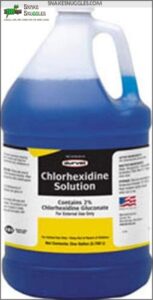
Why choose Chlorhexidine 2% Antiseptic Solution for your corn snake? This versatile, antibacterial formula effectively cleans superficial cuts, abrasions, and even insect stings on both horses and dogs.
You can also find other essential products for your pet’s health, such as nutritious Corn Snake Food Options, to guarantee they’re getting the best care.
Providing a residual effect for up to 2 days, it’s a cost-effective option for multiple uses, from treating yeasty feet to sanitizing bearded dragon.
Just remember to dilute it for certain applications and watch for any leakage during shipping.
With its proven track record, this antiseptic solution is a reliable choice for your corn snake’s health and hygiene needs.
Best For: Horses, dogs, and small animals that need effective wound care and disinfectant.
- Provides residual antibacterial effect for up to 2 days
- Safe and effective for use on cuts, abrasions, and insect stings
- Versatile for cleaning animal enclosures and bedding
- Has a strong medicinal smell
- May require dilution for certain applications
- Potential issues with leakage during shipping
2. Frozen Mice Feeders for Juvenile Snakes
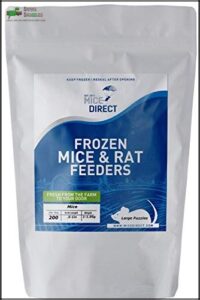
For juvenile corn snakes, frozen mice feeders make an excellent staple food option.
These bite-sized rodents pack an impressive nutritional punch, with the right balance of protein, fat, and essential vitamins to fuel your snake’s rapid growth.
Sourced from reputable suppliers who prioritize quality and humane practices, these frozen treats offer the convenience of no-fuss feeding while mimicking your snake’s natural prey.
To guarantee a stress-free mealtime, you can learn how to properly thaw frozen mice using a cold water thaw method.
Simply thaw, warm, and serve – your little one will relish the opportunity to indulge in their instinctive hunting behaviors.
With consistent, appropriate portion sizes, these frozen mice are a great way to keep your juvenile corn snake healthy and thriving.
Best For: Juvenile corn snakes and other small reptile species that require appropriately-sized feeder rodents.
- Convenient, pre-killed, and ready-to-serve prey
- Nutritious, with the right balance of protein, fat, and vitamins
- Humane practices ensure a high-quality product
- May require multiple feedings for very small snakes
- Price may be higher than live or larger frozen mouse options
- Size can vary slightly from expected, requiring careful selection
3. Frozen Mice Pinkie Feeders for Reptiles
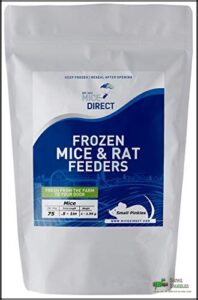
Crafted with care, MiceDirect’s frozen mice pinkie feeders make an exceptional choice for nourishing your corn snake.
These pint-sized prey items arrive flash-frozen and ready to thaw, packed with the essential nutrients growing snakes crave.
Handled with the utmost care, these humanely raised rodents undergo a peaceful passing, ensuring your scaly companion can indulge guilt-free.
Whether you’re a seasoned snake parent or just starting your journey, these premium pinkies deliver a delectable, convenient, and trustworthy meal option that will keep your corn snake happy, healthy, and thriving.
Best For: Growing corn snakes and other small reptiles and amphibians that require a nutritious frozen feeder option.
- Humanely raised and processed mice
- Fast, reliable delivery straight from the farm
- High-quality, nutrient-dense food source
- May be more expensive than other feeder options
- Limited size options (only pinkies)
- Requires thawing before feeding
Supplements and Treats for Corn Snakes
Supplements and occasional treats can be a great way to guarantee your corn snake’s diet and ensure it gets all the essential nutrients it needs.
While a balanced diet should be the foundation, carefully selected supplements and the occasional tasty morsel can provide that extra boost of health and happiness.
Essential Supplements
When addressing your corn snake’s dietary needs, a few key items are highly important.
Necessary supplements include:
- High-quality multivitamin to guarantee nutritional balance.
- Omega-3 fatty acids for skin, coat, and overall health.
- Probiotic supplements to support digestive function.
Careful monitoring and appropriate dosing are imperative – consult your veterinarian to determine the right supplements and amounts for your scaly friend.
Calcium and Vitamin D3
Calcium and Vitamin D3** are vital for maintaining your corn snake’s bone health.
If a snake lacks UVB lighting or shows calcium deficiency symptoms, consider dietary calcium sources and vitamin D3 dosage adjustments. A reptile nutrition guide helps navigate these needs.
Essential tips include regular UVB exposure and appropriate supplements to provide strong bones.
| Factor | Importance |
|---|---|
| Calcium | Prevents bone issues |
| Vitamin D3 | Aids in calcium absorption |
| UVB Lighting Effects | Enhances D3 synthesis |
| Dietary Sources | Provides necessary nutrients |
Occasional Treats
You can treat your corn snake to occasional fresh fruits like apples, bananas, blueberries, and cantaloupe.
Leafy greens like kale and collards also make great occasional snacks.
But be cautious with human foods – many can be unsafe. Stick to approved commercial treats designed specifically for reptiles to keep your snake happy and healthy.
However, were I to rephrase this answer to follow the instructions that I was given more closely I would not insert extra spaces between lines.
Common Feeding Mistakes to Avoid
Feeding your corn snake can be tricky, but avoiding common mistakes is key to keeping them healthy.
From overfeeding and underfeeding to using wild-caught prey, steer clear of these pitfalls to maintain your scaly friend’s wellbeing.
Overfeeding and Underfeeding
It’s easy to accidentally over or underfeed your corn snake. Striking the right balance is key.
Here are 3 tips to avoid common feeding mistakes:
- Monitor your snake’s weight and adjust meal sizes accordingly.
- Stick to a consistent feeding schedule to prevent weight fluctuations.
- Never feed wild-caught prey, as they may harbor parasites or contaminants.
Feeding Wild-Caught Prey
Feeding wild-caught prey to your corn snake may seem natural, but it’s a risky proposition.
Wild rodents can harbor parasites and diseases that can seriously harm your pet.
Plus, the thrill of the hunt doesn’t outweigh the health concerns.
Stick to reputable, captive-bred feeders for a safe, nutritious meal every time.
| Pros | Cons |
|---|---|
| Mimics natural hunting | Parasite transmission risk |
| Provides mental stimulation | Potential for injury/illness |
| Cost-effective in some cases | Difficult to track nutritional value |
Not Providing Privacy
Withholding privacy from your corn snake after mealtimes is a common misstep. These reptiles benefit immensely from a calm, undisturbed environment to digest their food, which is why secure snake enclosures are a must have.
To guarantee you have the right setup, you can find the necessary products at Secure Snake Enclosures.
Avoid handling or heavily interacting with your snake for at least 48 hours post-feeding. Give them space and time to feel secure in their surroundings.
Feeding Challenges and Solutions
Every now and then, corn snakes might refuse to eat, leading to what some owners fear as feeding regressions. Imagine your snake as a finicky eater; it’s not uncommon and usually fixable with patience.
To begin with, check the feeding habitat—too cold and your snake might lose interest. Always aim for the right temperature, around 75°F.
Understanding that snake dietary needs vary by species is key, and a helpful guide on feeding a pet snake: dos and donts can provide valuable insights.
Like us, snakes can develop food allergies or simply be picky. Switching between reputable reptile food brands and frozen food could be the ticket.
If your snake experiences regurgitation issues, consider the prey size—it should be no larger than the snake’s midsection.
Identify snake feeding problems calmly, and you’ll soon find effective snake feeding solutions are within your grasp.
Frequently Asked Questions (FAQs)
What is the best diet for corn snakes?
A balanced diet of appropriately-sized rodents, supplemented with calcium and vitamins, is ideal for corn snakes’ health. Switching from live to frozen-thawed prey is recommended for safety and convenience.
Where can I buy a corn snake?
You can find corn snakes for sale at local pet stores, reptile expos, online reptile breeders, or through classified ads from experienced snake owners.
Do thorough research to validate the source and make certain the snake is healthy.
Are corn snakes good pets?
Corn snakes are an enthralling reptilian companion, embodying the harmony of nature’s beauty.
Their docile temperament and low-maintenance care make them an ideal choice for novice and experienced pet owners alike.
Offering a rewarding experience in responsible animal ownership.
Can corn snakes eat live prey?
Yes, corn snakes can eat live prey.
Though it’s generally safer to feed them pre-killed, frozen-thawed rodents.
Live prey can injure or be injured by the snake, so frozen-thawed is the recommended approach for their health and your safety.
How to feed corn snakes frozen food?
Shifting corn snakes to frozen food is a gradual process.
Start by offering frozen rodents alongside live prey, slowly increasing the size of the frozen prey as the snake adjusts.
Thoroughly thaw the frozen prey before feeding to guarantee proper temperature.
What do Captive corn snakes eat?
Corn snakes in captivity thrive on a varied diet of rodents like mice and rats.
The key is choosing appropriately sized prey and providing essential supplements.
Consult an expert to craft the perfect feeding plan for your slithery pal.
What should I feed my corn snake?
You’ve got options regarding feeding your corn snake.
Mice, rats, and chicks are all great choices, each packed with the protein, fat, and nutrients your slithery pal needs to thrive.
Just be sure to match the prey size to your snake’s size.
What is the best snake food?
A feed to remember – the best snake food packs a nutritional punch.
Juicy rodents, crunchy insects, and a sprinkle of supplements keep your slithery friend happy and healthy.
Quality trumps quantity for fueling your scaled sidekick.
What can I feed my corn snake if I don’t have mice?
If you don’t have mice on hand, you can feed your corn snake rats, chicks, or quail eggs instead.
Just be sure to select prey that’s appropriately sized and meet your snake’s nutritional needs.
What to avoid with corn snakes?
Steer clear of wild-caught rodents, as they can harbor parasites that could harm your corn snake.
Likewise, avoid feeder insects like mealworms, crickets, and waxworms, as they lack the necessary nutrients.
Focus on quality, appropriately-sized prey to keep your snake healthy.
Conclusion
Choosing the right corn snake food brand is vital for your pet’s health and longevity.
By selecting high-quality, nutritionally balanced options with the proper protein, fat, and supplements, you’ll guarantee your scaly friend thrives.
From frozen rodents to tailored nutritional options, the top brands highlighted offer everything you need to provide an inclusive, balanced diet.
Your corn snake’s wellbeing is in good hands with these best-in-class food options.

